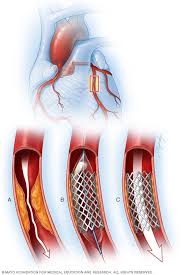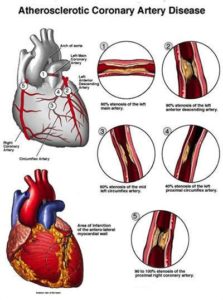“Treatments for coronary heart disease include heart-healthy lifestyle changes, medicines, medical procedures and surgery, and cardiac rehabilitation.”
National Heart, Lung and Blood Institute
“Treatments for coronary heart disease include heart-healthy lifestyle changes, medicines, medical procedures and surgery, and cardiac rehabilitation.”
National Heart, Lung and Blood Institute
 Surgery inserting a stent
Surgery inserting a stentMaking a commitment to the following healthy lifestyle changes can go a long way toward promoting healthier arteries:
Various drugs can be used to treat coronary artery disease, including:
If you’ve had a heart attack, aspirin can help prevent future attacks. There are some cases where aspirin isn’t appropriate, such as if you have a bleeding disorder or you’re already taking another blood thinner, so ask your doctor before starting to take aspirin.
Surgical procedure in which one or more blocked coronary arteries are bypassed by a blood vessel graft to restore normal blood flow to the heart. These graft usually come from the patient’s own arteries and veins located in the chest (thoracic), leg (saphenous) or arm (radial). The graft goes around the blocked artery (or arteries) to create new pathways for blood to flow to the heart.
Sometimes more aggressive treatment is needed. Here are some options:
A stent is often left in the artery to help keep the artery open. Some stents slowly release medication to help keep the artery open.
Omega-3 fatty acids are a type of unsaturated fatty acid that’s thought to reduce inflammation throughout the body, a contributing factor to coronary artery disease. However, recent studies have not shown them to be beneficial. More research is needed.
“Plaque“ might begin to build up where the arteries are damaged. The buildup of plaque in the coronary arteries may start in childhood. Over time, plaque can harden or rupture (break open). Hardened plaque narrows the coronary arteries and reduces the flow of oxygen-rich blood to the heart. This can cause angina (chest pain or discomfort).”
National Heart, Lung and Blood Institute

Coronary artery disease is thought to begin with damage or injury to the inner layer of a coronary artery, sometimes as early as childhood. The damage may be caused by various factors, including the following which are problems we can prevent or better control through better diet, some form of exercise balanced with rest. Including keeping our stress controlled in a productive way (like work out program to doing hobbies).
Causes that are modifiable (that we can change or help control):
Learn more tomorrow on treatment of CAD in Part III!
“Coronary artery disease develops when the major blood vessels that supply your heart with blood, oxygen and nutrients (coronary arteries) become damaged or diseased=narrowing or blockages of the arteries=decreased blood flow to heart tissue.”
American Heart Association
Coronary artery disease develops when the major blood vessels that supply your heart with blood, oxygen and nutrients (coronary arteries) become damaged or diseased. Cholesterol-containing deposits (plaque) in your arteries and inflammation are usually to blame for coronary artery disease.
To better understand how CAD operates here is a metaphor like when we drive our car if our transmission is temporarily blocked the engine struggles to operate ( Just like in this disease CAD you get symptoms or no specific symptoms with resulting to struggle to do your activities of daily living)with a temporary block and definitely a complete block). Ending probem with CAD the you need the blockage resolved so the blood can get 100% oxygen from our lungs (they provide blood oxygen to the red blood cells that provide this nutrient to our tissues to stay alive–without it our body goes through starvation=no oxygen to tissure=pain like angina). So again as a metaphor using the car, the engine of the body is the heart, the transmission of the body is the lungs (one can’t live without the other) and the kidney system ( that filters our blood removing toxins from it to keep our blood stream cells clean) that would be the oil system of the car. All the systems have a function that relate to the body in keeping it alive. If oxygen is deprived long enough or toxins just continue to build up in our body it will die without resolution to getting back to normal or providing some oxygen or removing some toxins of the body like through hemodialysis for exampte.
When plaque builds up, they narrow your coronary arteries, decreasing blood flow to your heart. Eventually, the decreased blood flow may cause symptoms like chest pain (This pain, referred to as angina, usually occurs on the middle or left side of the chest. Angina is generally triggered by physical or emotional stress. It maybe triggered by stress the cause is lack of oxygen=nutrients to our body).
The symptom shortness of breath– is also caused by lack of oxygen due to this blockage which could be partial or complete in our major blood vessels and there are other coronary artery disease signs and symptoms (which are listed below).
A partial or complete blockage can cause a heart attack.
Because coronary artery disease often develops over decades, you might not notice a problem until you have a significant blockage with or without specific symptoms to even a heart attack. Remember many heart attacks can be silent: that is why at a certain age we should be having a 6mth or yearly check up by a cardiologist (the expert) but if your insurance doesn’t cover a referral than go to your general doctor for a yearly physical or sooner. But there’s plenty you can do to prevent and treat coronary artery disease. A healthy lifestyle can make a big impact on prevention or even help treating CAD.
Women are somewhat more likely than men are to experience less typical signs and symptoms of a heart attack, such as neck or jaw pain. Sometimes a heart attack occurs without any apparent signs or symptoms.
Learn more about the causes, risks that put you more at causes and risks of CAD tomorrow in Part II!
“Check your car seat before holiday travel. Seventy-three percent of car seats are not used or installed correctly, so check it before you hit the road.Prepare for weather emergencies, if you live in a cold-weather state. Pack extra blankets, food and diapers, in case your car is stuck in snow or disabled. Keep your cell phone charged, make sure someone knows your route, and clear the exhaust of packed snow. ”
safekids.org
The Electrical Safety Foundation states:
1. Inspect electrical decorations for damage before use.
Cracked or damaged sockets, loose or bare wires, and loose connections may cause a serious shock or start a fire.
2. Do not overload electrical outlets.
Overloaded electrical outlets and faulty wires are a common cause of holiday fires. Avoid overloading outlets and plug only one high-wattage into each outlet at a time.
3. Never connect more than three strings of incandescent lights.
More than three strands may not only blow a fuse, but can also cause a fire.
4. Keep trees fresh by watering daily.
Dry trees are a serious fire hazard.
5. Use battery-operated candles.
Candles start almost half of home decoration fires (NFPA).
6. Keep combustibles at least three feet from heat sources.
A heat sources that was too close to the decoration was a factor in half of home fires that began with decorations (NFPA).
7. Protect cords from damage.
To avoid shock or fire hazards, cords should never be pinched by furniture, forced into small spaces such as doors and windows, placed under rugs, located near heat sources, or attached by nails or staples.
8. Check decorations for certification label.
Decorations not bearing a label from an independent testing laboratory such as Underwriters Laboratories (UL), Canadian Standards Association (CSA), or Intertek (ETL) have not been tested for safety and could be hazardous.
9. Stay in the kitchen when something is cooking.
Unattended cooking equipment is the leading cause of home cooking fires (NFPA).
10. Turn off, unplug, and extinguish all decorations when going to sleep or leaving the house.
Unattended candles are the cause of one in five home candle fires. Half of home fire deaths occur between the hours of 11pm and 7am (NFPA).
Stay safe on the roads over the holidays and every day:
“The week running up to the Holidays – In the week running up to Christmas, criminals are mainly targeting Auto Dealerships and Warehouses. Criminals target these businesses during their busiest period for the Christmas haul of cash and the valuable stock kept on site. In the week that was leading up to Christmas Day 2016, Netwatch recorded a 33% increase in attempted security breaches, with a third of all activity taking place between the hours of 6pm and 12am.”
netwatchusa.com